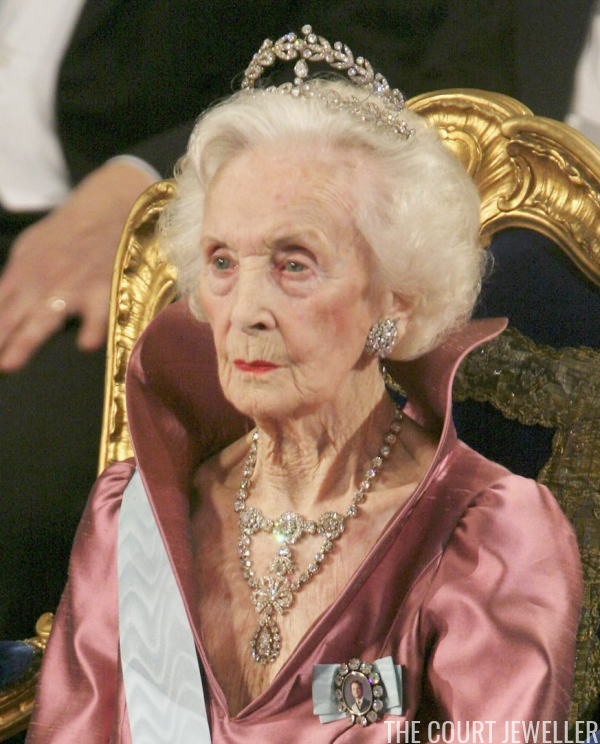 |
| The Boucheron Laurel Wreath Tiara (Photo: JONATHAN NACKSTRAND/AFP/Getty Images) |
One of the most unusual tiaras in any royal collection is today’s topic of discussion: the Boucheron Laurel Wreath Tiara. The sparkler, which belongs personally to Crown Princess Victoria of Sweden, has a lengthy and interesting history within the Bernadotte family.
The convertible tiara/necklace, which was made by Boucheron, was given to Margaret by her new husband’s grandmother, Queen Sofia of Sweden. The piece may have been a stock item in Boucheron’s collection rather than a specific commission by the queen, as another nearly identical necklace by Boucheron was auctioned at Christie’s in 2010. (Boucheron has also released archive photos of a similar piece — that’s the image pictured above.) That necklace differs from Margaret’s in only one aspect: Margaret’s appears to have one additional diamond suspended from the center of the necklace, something that the auctioned necklace lacks. (This additional diamond drop is also visible when the piece is worn as a tiara.) Christie’s notes that the auctioned necklace was made in the late nineteenth century, which could certainly also be true for Margaret’s necklace — she received hers in 1905. The auctioned necklace is also listed as a “necklace-tiara,” which suggests that both pieces were intended to be convertible from the start.
 |
| Crown Princess Margareta wears the necklace (Photo: Wikimedia Commons) |
But Margaret apparently never wore the piece as a tiara; she was only ever photographed wearing it as a necklace. Photographs show her wearing the necklace with full Swedish court dress, including her Irish lace veil and the diamond “forget-me-not” tiara she received from her parents as a wedding gift. The necklace was not worn in public as a tiara until more than half a century after Margaret’s death, when her daughter-in-law, Princess Lilian, began wearing the piece to official functions.
 |
| Princess Lilian wears the tiara in 2003 (Photo: SVEN NACKSTRAND/AFP/Getty Images) |
Lilian obtained the right to wear the laurel wreath after she began a relationship with Margaret’s third son, Prince Bertil. The laurel wreath necklace is one of the jewels that he inherited from his mother; another one of the pieces that he received was her fascinating scarab necklace. Lilian and Bertil had something of a star-crossed love affair. They met and fell in love in England during the war, but Lilian was already married to someone else. Even though she and her husband amicably divorced, marriage to Bertil was still out of the question for more complicated reasons.
 |
| Princess Lilian wears the tiara in 2006 (Photo: Pascal Le Segretain/Getty Images) |
Marrying Lilian would have caused Bertil to lose his place in the Swedish succession; Bertil’s grandfather, the king, would not have approved their “unequal” marriage. It wasn’t uncommon for Swedish royal men to chose love over titles (two of Bertil’s brothers did, in fact), but Bertil needed to keep his place in line so that he could serve as regent for his nephew, Carl Gustaf, should he have become king before his eighteenth birthday. (Because Carl Gustaf’s father had died in a plane crash, which meant that he became the heir to the throne at the age of four, this was a real possibility.) So Bertil and Lilian waited to get married, choosing duty to the family over legal recognition of their relationship.
 |
| Princess Lilian wears the tiara in 2006 (Photo: Chris Jackson/Getty Images) |
But although their relationship could not be legally sanctioned, Lilian was accepted as a member of the royal family. This tiara was actually one of the public symbols of that acceptance. She wore it in public for the first time in 1972 at the 90th birthday celebrations of Bertil’s father, King Gustaf VI Adolf. Even today, it’s highly unusual for unmarried partners of royal men to wear tiaras to family occasions, and when it’s done, it generally signals that they are considered a part of the royal fold, marriage certificate or not. (See also: Bertil and Lilian’s great-nephew, Prince Gustav of Sayn-Wittgenstein-Berleburg, and his partner, Carina Axelsson.)
 |
| Photo: SVEN NACKSTRAND/AFP/Getty Images |
After Carl XVI Gustaf became king, he granted permission for his Uncle Bertil to marry Lilian and keep his royal titles. They wed in Drottningholm Palace in 1976, and Lilian officially became a Swedish princess. She attended many official functions with the royal family over the years, including the Nobel ceremonies, and she often wore her mother-in-law’s laurel wreath at those events. She became an important part of the royal family, even acting as a sort of surrogate grandmother for Crown Princess Victoria, Prince Carl Philip, and Princess Madeleine.
 |
| Crown Princess Victoria wears the tiara (Photo: Pascal Le Segretain/Getty Images) |
The laurel wreath tiara became Lilian’s sole personal property on the death of Prince Bertil in 1997. After suffering from Alzheimer’s disease, Lilian died in March 2013. She made sure that this heirloom tiara stayed with the Bernadottes, bequeathing it to her great-niece, Crown Princess Victoria. Victoria wore the tiara for the first time in public at her sister’s wedding in June 2013 — a lovely gesture that provided a reminder of Lilian at an event she would certainly have loved to have attended.
Leave a Reply